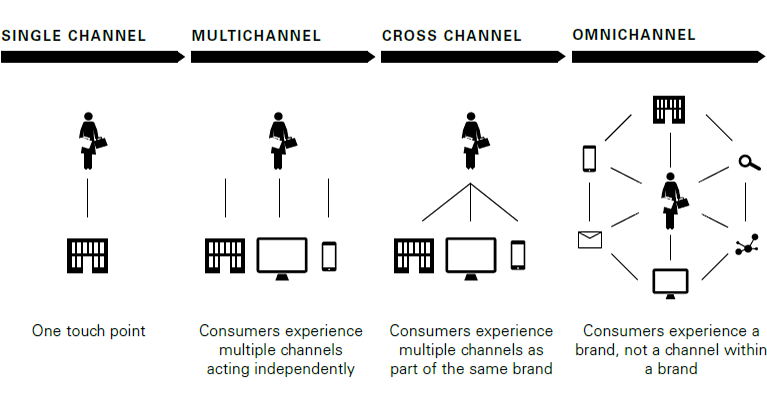In today's international fashion business literature, "Omnichannel" is one of the most overused - even abused - words. For those who belong to my generation (1965 – technically called Generation X), who became adults by experiencing the atmosphere and magic of physical retail stores, travelling around the world meant experiencing different formats and concepts. Each represented a unique communication channel between a "passive" consumer and proactive - almost "dictatorial"- brands.

From single channel to omnichannel shopping experience
Between the 90s and the 2000s, offering an e-commerce experience used to be the bleeding edge of retail. Now it's a requirement for survival
The expansion of fashion distribution towards e-commerce started mainly in Anglo-Saxon markets in the late 1990s - early 2000s (e.g., Ralph Lauren launched their e-commerce in the US in 2001). The first multi-brand fashion e-commerce platforms, such as Luisaviaroma, Net-A-Porter and Yoox, appeared in 1999, and it did take some time before they became the successful giants they are today.
For the first ten years, fashion e-commerce developed as a different free-standing channel, often managed by several external service companies - including a dedicated business unit created by Yoox, both for portable devices and desktop users (multichannel).
Then came cross-channel marketing
From 2010 onwards, major fashion luxury brands began to understand the importance of directly driving their second and third channels. They tried to conceive and give their consumers - who had become much more proactive and free-minded – a unique brand experience based on multiple channels as part of the same whole (cross-channel).
Then technology-driven omnichannel retail revolution changed the rules of the game. And so did UGC: what is a user-generated content, and why it is important
Over the past five years, consumers of the new generations (including Generation Alpha, the first true digital natives) have been pushing to be allowed to use and somehow take control of different brand-related channels for a consumer-driven experience, gaining autonomy and authority. This includes new social media scenarios where consumers are more central than ever.
It was the birth of omnichannel, which implies absolute continuity in the shopping experience. This allows users to own their data and experience. It enables them to use these data and, at some point, guide the creation of products and content, including images, videos, reviews or podcasts on Internet forums, blogs, social media or other channels (collectively known as UGC-User-Generated Content, or UCC-User-Created Content).
Most consumers do not even think in terms of traditional channel boundaries, evaluating brands and retailers on the seamlessness of their experience
With the omnichannel approach, consumers can jump between physical and virtual shop experiences through smartphones, tablets, social media, call centres, or email accounts. This gives them a wide range of ways to purchase and interact with a brand or retailer through a seamless, often fully customisable, anytime-anywhere-anyhow experience. Customers have access to a complex set of touchpoints, learning more about the products that interest them most.
Fashion literature and business experts have well recognised the social media revolution, which has enabled the rise of a two-way dialogue and interaction between brands and customers, increasingly driven by the latter – most notably on the newest and hottest platforms as TikTok. In short, omnichannel has integrated social media into the daily interaction between brands and consumers, adding the link to online shopping.
Live shopping events have already been taking place in China for several years and will soon get to Europe. The first experiments have recently been hosted on some of China's most giant platforms, allowing top Italian fashion and luxury retailers to hold live shopping events with thousands of wealthy Asian consumers looking for exclusive products and brands.
Is omnichannel dying or thriving? It's here to stay, but the secret is a personalisation strategy
In this fast-growing revolution, the Covid pandemic across 2020-2021 has given an incredible boost to both e-commerce and consumers' willingness to interact by harnessing digital technology. We have a new opportunity for interaction through 3D, virtual reality (VR) and augmented reality (AR), which intersect digital and gaming experiences with real life. This is relevant to both B2C and B2B through the impressive expansion of digital platforms such as joor.com, enabling thousands of real-time interactions between companies/brands and retailers every day.
What is next? The spread of NFTs (non-fungible tokens, some sort of digital certificates of authenticity) applied to fashion gaming and retail is still to be understood in its actual extent and consequences. The future of physical shops will also depend on brands' power and ability to surprise and engage consumers through new experiences that embrace both the real world and real-time digital technologies.
Andrea Davide Doroldi
Fashion Business Lecturer, three-year courses and Master's programmes, Milan

